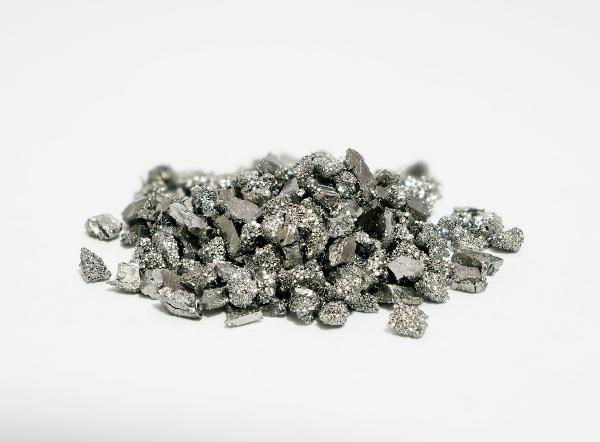THE tungsten, symbol W, atomic number 74, is a group 6 metal of the TThe beauty Periodic. Its main characteristic is the fact that it is the metal with the highest melting temperature and the second element with the highest melting temperature, second only to the carbon. It has a gray color, referring to steel, is stable in air, but burns when heated.
Tungsten is present in two everyday products: ballpoint pens and incandescent lamps (with filaments). However, in industry, tungsten is widely used in the manufacture of metal alloys and as an additive to the steel. It is also present in jewelry and smart windows, devices that manage to control the intensity of sunlight that falls on a location, improving energy efficiency.
Read more: Metals — elements characterized by brightness, strength, thermal and electrical conductivity
tungsten summary
It is a transition metal, being in group 6 of the Periodic Table, in the sixth period.
It is the metal with the highest melting point on the Periodic Table.
It is gray in color and is stable in air.
Much of it is taken from wolframite and scheelite.
It is used to manufacture incandescent lamps, ballpoint pens, jewelry, smart glasses, among others.
tungsten properties
Symbol: W
atomic number: 74
atomic mass: 183.84 a.m.u.
Fusion point: 3422 °C
Boiling point: 5555 °C
Density: 19.3 g/cm³
electronegativity: 2,36
Eletronic distribution: [Xe] 6s2 4f14 5d4
Chemical series: group 6, transition metal, d-block
Do not stop now... There's more after the advertising ;)
Tungsten Characteristics
Tungsten is a grayish metal, the coloring of which can resemble steel. What stands out the most is its very high melting point, 3422 °C, the largest among metals and the second largest on the Periodic Table, second only to carbon. Some properties and characteristics of tungsten are very similar to molybdenum, another element in group 6.
As for reactivity, this metal is stable in the presence of air at room temperature, however, at higher temperatures, it ends up suffering combustion the WO3, one of the main compounds of this element. tungsten is easily oxidized by halogens, acquiring oxidation states ranging from +2 to +6. It is resistant to acid attack, including aqua regia, but is quickly attacked by molten bases in the presence of oxidizing agents.

Occurrence and production of tungsten
tungsten is the 18th most abundant element of the Earth's crust, occurring mainly in wolframite (or wolframite), (Fe, Mn) WO ores4, scheelite (CaWO4), ferberite (FeWO4) and hubnerite (MnWO4). The first two, wolframite and scheelite, with high contents of WO3, are the main sources of this metal around the world.

Most of the planet's tungsten is located in the China, Russia, Vietnam, Spain and ColorandI was going from the north. Chinese reserves represent more than half of the entire planet, with China accounting for more than 80% of the world's tungsten production. THE Brazil it has wolframite reserves in the states of Pará, Rondônia, Rio Grande do Sul, Santa Catarina and São Paulo, and scheelite in the Seridó region, between Paraíba and Rio Grande do Norte. Brazilian tungsten reserves represent around 1% of the world total.
For its production and procurement, first of all, tungsten ores need to undergo physical crushing and grinding processes. Then, one of the ways to obtain tungsten is by fusion with sodium carbonate (Na2CO3) at high temperature, producing sodium tungstate (Na2WO4), what is soluble in water.
the addition of hydrochloric acid generates tungstic acid, later converted to tungsten oxide VI, WO3, via calcination (chemical method in which samples are converted at high temperatures). of the WO3, it is possible to produce metallic tungsten via redox with hydrogen gas or with carbon at high temperature. Sometimes there is the production of carbide (or carbide) from tungsten, WC or W2C, as a final product, known as carbide.
Read more: Mining - consists of extracting and processing underground ores
Tungsten Applications
In industrial and commercial terms, tungsten carbide is widely used as a coating of high speed cutting and drilling tools, as drill bits for drills, since it has high hardness and high mechanical resistance.

Tungsten is also a good additive for steel, being used in the production of high speed steel (8% to 20% of W) and of tool and die steels (5% to 18% of W). These steel modalities are used in the manufacture of abrasion resistant cutting materials and blades.
Closer to the daily lives of societies, tungsten is a major component of incandescent light bulbs, being the main component of the metallic filament of these lamps. The use of tungsten in them decreed the end of the use of carbon, osmium and tantalum as filaments. While carbon lamps, developed by Thomas Edison, lasted a few hours, osmium ones were very expensive and tantalum ones were very fragile.
Tungsten is also used in the production of ballpoint pens, invented by the Hungarian László Biró and popularized in Europe by Marcel Bich. In these pens, ink is deposited on the paper via a rolling ball at the tip of the pen. As this sphere needed to be of high hardness and density, tungsten proved to be an excellent candidate, precisely because it contained such properties.

Tungsten has application in jewelry making, since it presents itself as a hypoallergenic material, with a density close to that of gold, being resistant to scratches, deformations and scratches, in addition to a practically permanent shine, that is, no need for polishing constants. tungsten rings, for example, are much sought after for their good durability, appearance and hardness, in addition to, of course, having a lower price in relation to more noble metal alliances.

A more technological use of tungsten is in manufacture of smart windows (smart windows), which have an electrochromic film capable of controlling the intensity of light and heat incident on an environment, ensuring greater luminous and energetic efficiency of the place. Such devices are already appearing on the market, both in cars and in real estate in general, and can be controlled remotely.
Read more:Differences between fluorescent and incandescent lamps
tungsten history
Tungsten has a intriguing story about your name, or rather their names, since it is also known as wolfram, in Germanic and Slavic languages.
In 1783, in Spain, the brothers Juan José and Fausto Delhuyar were the first to isolate tungsten as a pure element, having the mineral as its origin wolframite. The Spanish brothers then decided to call the new element wolfram (a translation for wolfram), on account of the originating ore. The name wolfram is derived from the German, wolf rahm, which translates as drool or wolf saliva, a reference to tin losses during the processing of tungsten ores.
However, the decision taken by the Delhuyar brothers to name the new element as wolfram created some confusion, as two years earlier, between 1779 and 1781, the Irish Peter Woulfe and the swedish Carl Wilhelm Scheele discovered an acidic compound today acid tungstic, based on the mineral tungstenite (now known as scheelite, CaWO4). From this acidic compound, they isolated the oxide of tungsten VI, WO3.
Although the Spanish brothers were ahead, even for having managed to isolate the metal, the new element was also known worldwide as tungsten, a junction of Swedish words tung (heavy) and sten (stone) and referring to tungstenite metal.
However, although both names persist to this day, the internationally adopted symbol for tungsten is the W, due to the German name wolfram. The name tungsten is more common in English and Latin languages.
tungsten exercises
Question 1 (Uece)
Note the following quotes about tungsten: “My uncle appreciated the density of the tungsten he prepared, its refractoriness, its great chemical stability […]”; "The feeling of touching the sintered tungsten is incomparable."
SACHS, Oliver. uncle tungsten: Company of pocket.
For tungsten, tick the true option.
a) The electronic distribution of tungsten is [Xe] 4f14 5d6.
b) Belongs to group 5 of the Periodic Table.
c) It is a transition metal, with a high melting point.
d) It is located in the fifth period of the Periodic Table.
Reply: letter C
Among the alternatives, the one that is true about tungsten is the letter C, as this element is a metal of transition (group 6) and has, in fact, a high melting point (the highest among metals and the second highest in the Table Periodic).
Statement A is wrong as its distribution is [Xe] 6s2 4f14 5d4.
Alternative B is wrong, as this element belongs to group 6 of the Periodic Table.
Alternative D is wrong, as this element is located in the sixth period of the Periodic Table.
Question 2 (Uepa)
“Tungsten is the only metal in the 3rd transition line of the Periodic Table with a proven biological function. It appears in some bacteria and in enzymes called oxidoreductases, playing a similar role to molybdenum in oxidoreductases in the human body. Tungsten has the highest melting point of all metals, second only to carbon in the entire Periodic Table. It is acid resistant and HNO blend only3 + HF dissolves it slowly when hot. It resists well to alkaline solutions, but is attacked by fusions with NaOH or Na2CO3, converting into tungstates. the WO3 it is used as a pigment and also to color ceramic materials. The CaWO tungstates4 and MgWO4 they are components of the white powder that coats fluorescent bulbs internally. Sodium and potassium tungstates are used in the leather and skin industry, in the precipitation of blood proteins and in clinical analysis. For metal purification, natural tungstates are subjected to fusion with sodium carbonate (Na2CO3) at high temperature, resulting in sodium tungstate (Na2WO4), soluble in water. From this solution, upon addition of HCl, tungstic acid (H2WO4), which is converted WO3 after calcination. Metallic tungsten is obtained through the reduction of WO3 with reducing gas (H2) at high temperature. The metal is obtained in the form of powder, filaments or solid bars"
(Source: Química Nova na Escola).
Regarding what is exposed in the text, it is correct to state that:
a) the CaWO species4 and MgWO4 are Arrenhius acids.
b) CaWO species4 and WO3 are basic oxides.
c) the NaOH or Na species2CO3 they are bases of Arrenhius.
d) the reaction between Na species2WO4 and HCl produces species H2WO4.
e) calcination of H2WO4 produces tungsten dioxide.
Reply: letter D
There is an excerpt from the text of the question that says: “...resulting in sodium tungstate (Na2WO4), soluble in water. From this solution, upon addition of HCl, tungstic acid (H2WO4)…” precipitates, that is, the reaction between sodium tungstate and HCl results in species H2WO4, and, therefore, the template is that of the letter D.
Alternative A is incorrect as the chemical species cited are not acids but salts.
Alternative B is incorrect as CaWO4 is not an oxide, and furthermore WO3 is an acidic oxide, as it originates from the dehydration of tungstic acid:
H2WO4 → WO3 + H2THE
Alternative C is incorrect as, by Arrhenius' theory, only NaOH can be considered a base. In this theory, bases are species that increase the concentration of OH- ions in aqueous solution. And in2CO3 does not have, in its structure, the hydroxide ion, it cannot be seen as a basis in light of Arrhenius' theory.
Alternative E is incorrect as tungstic acid produces tungsten trioxide and not dioxide.
By Stéfano Araújo Novais
Chemistry teacher



